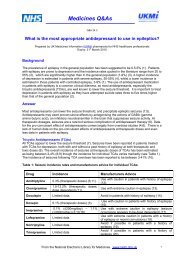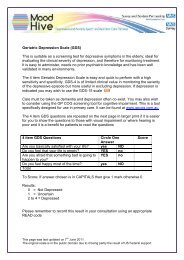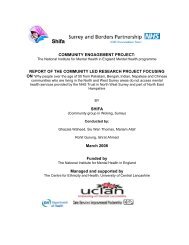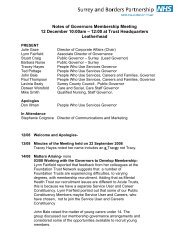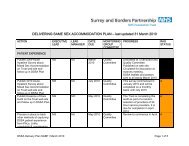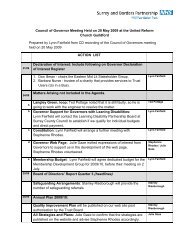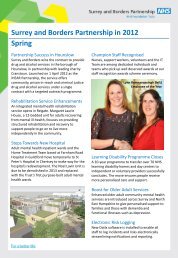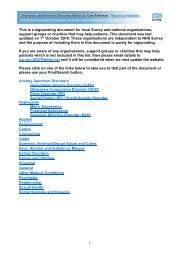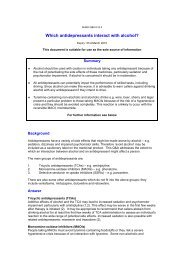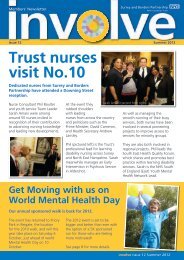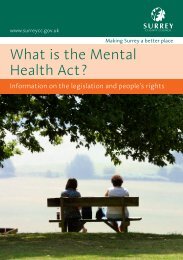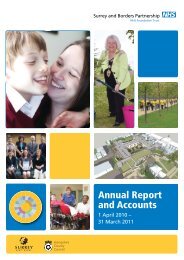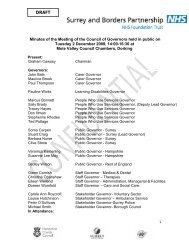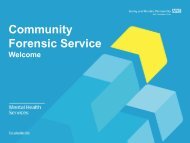Here - Surrey and Borders Partnership NHS Foundation Trust
Here - Surrey and Borders Partnership NHS Foundation Trust
Here - Surrey and Borders Partnership NHS Foundation Trust
You also want an ePaper? Increase the reach of your titles
YUMPU automatically turns print PDFs into web optimized ePapers that Google loves.
Research <strong>and</strong> Audit<br />
Based on the results of the initial audit,<br />
strategies to improve performance were<br />
implemented. An e-mail was circulated to<br />
all consultants <strong>and</strong> junior doctors<br />
involved in risk assessment for adult inpatients<br />
highlighting the outcomes <strong>and</strong><br />
raising awareness of the need for<br />
adequate risk assessment. The three<br />
questions <strong>and</strong> the need to fulfill these<br />
were documented in the e-mail along<br />
with the intent to re-audit in 2 months’<br />
time. As the changeover for junior<br />
doctors occurred shortly after the audit,<br />
this e-mail was circulated to both those<br />
doctors completing their post <strong>and</strong> those<br />
taking over from them.<br />
Re-audit<br />
A re-audit was undertaken in May 2009.<br />
23 sets of notes were r<strong>and</strong>omly selected<br />
from all the in-patients currently on ACU<br />
(split equally across Blake <strong>and</strong> Clare<br />
wards). The 23 notes selected were then<br />
examined using the method <strong>and</strong> analysis<br />
outlined in the initial audit. Results were<br />
obtained for an overall view of the<br />
different criteria being assessed. There<br />
was no breakdown of results by<br />
consultant or regularity of ward round as<br />
this showed no impact in the initial audit.<br />
Results were analysed depending on<br />
length of stay, as this was identified as<br />
having an impact. These results were then<br />
compared with those of the initial audit to<br />
see if the heightened awareness had<br />
altered the recording of risk assessment<br />
Based on the results of the first re-audit<br />
<strong>and</strong> the possible areas of bias, further<br />
strategies to improve performance were<br />
implemented <strong>and</strong> second re-audit<br />
conducted in November 2009, which was<br />
towards the end of the post for the<br />
cohort of doctors included. The second<br />
re-audit followed the same method <strong>and</strong><br />
structure as the earlier re-audit in May<br />
2009. This ensured that there had been<br />
consistency in the doctors completing the<br />
documentation over the last four months<br />
<strong>and</strong> also a long enough time period to<br />
ensure no notes had been included in the<br />
previous audit cycle. Formal teaching on<br />
risk assessment was delivered to the new<br />
cohort doctors at the beginning of their<br />
post in psychiatry at the ACU, Chertsey.<br />
This included an explanation of the risk<br />
assessment form <strong>and</strong> its importance, <strong>and</strong><br />
was conducted by one of the in-patient<br />
consultants.<br />
Results<br />
Fig.1 Initial audit – distribution overall<br />
100<br />
90<br />
80<br />
70<br />
60<br />
% 50<br />
40<br />
30<br />
20<br />
10<br />
0<br />
Criteria<br />
Initial RA<br />
Initial complete RA<br />
Regular updates<br />
RA accessible to staff<br />
Meets st<strong>and</strong>ard guidelines<br />
18 <strong>Surrey</strong> <strong>and</strong> <strong>Borders</strong> Online Journal www.sabp.nhs.uk/journal



